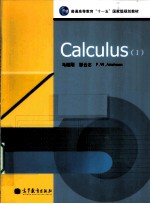

微积分 1 英文版PDF电子书下载
- 电子书积分:10 积分如何计算积分?
- 作 者:马继刚,邹云志,(加)P. W. Aitchison
- 出 版 社:北京:高等教育出版社
- 出版年份:2010
- ISBN:9787040292084
- 页数:228 页
CHAPTER 1 Functions,Limits and Continuity 1
1.1 Mathematical Sign Language 1
1.1.1 Sets 2
1.1.2 Numbers 3
1.1.3 Intervals 4
1.1.4 Implication and Equivalence 5
1.1.5 Inequalities and Numbers 6
1.1.6 Absolute Value of a Number 7
1.1.7 Summation Notation 9
1.1.8 Factorial Notation 10
1.1.9 Binomial Coefficients 10
1.2 Functions 13
1.2.1 Definition of a Function 13
1.2.2 Properties of Functions 18
1.2.3 Inverse and Composite Functions 21
1.2.4 Combining Functions 26
1.2.5 Elementary Functions 26
1.3 Limits 27
1.3.1 The Limit of a Sequence 27
1.3.2 The Limits of a Function 30
1.3.3 One-sided Limits 33
1.3.4 Limits Involving the Infinity Symbol 35
1.3.5 Properties of Limits of Functions 36
1.3.6 Calculating Limits Using Limit Laws 37
1.3.7 Two Important Limit Results 41
1.3.8 Asymptotic Functions and Small o Notation 46
1.4 Continuous and Discontinuous Functions 49
1.4.1 Definitions 49
1.4.2 Building Continuous Functions 52
1.4.3 Theorems on Continuous Functions 55
1.5 Further Results on Limits 58
1.5.1 The Precise Definition of a Limit 58
1.5.2 Limits at Infinity and Infinite Limits 61
1.5.3 Real Numbers and Limits 64
1.5.4 Asymptotes 65
1.5.5 Uniform Continuity 68
1.6 Additional Material 69
1.6.1 Cauchy 69
1.6.2 Heine 70
1.6.3 Weierstrass 70
1.7 Exercises 71
1.7.1 Evaluating Limits 71
1.7.2 Continuous Functions 73
1.7.3 Questions to Guide Your Revision 74
CHAPTER 2 Differential Calculus 75
2.1 The Derivative 75
2.1.1 The Tangent to a Curve 75
2.1.2 Instantaneous Velocity 76
2.1.3 The Definition of a Derivative 77
2.1.4 Notations for the Derivative 80
2.1.5 The Derivative as a Function 80
2.1.6 One-sided Derivatives 83
2.1.7 Continuity of Differentiable Functions 83
2.1.8 Functions with no Derivative 84
2.2 Finding the Derivatives 86
2.2.1 Derivative Laws 86
2.2.2 Derivative of an Inverse Function 89
2.2.3 Differentiating a Composite Function—The Chain Rule 91
2.3 Derivatives of Higher Orders 93
2.4 Implicit Differentiation 96
2.4.1 Implicitly Defined Functions 96
2.4.2 Finding the Derivative of an Implicitly Defined Function 97
2.4.3 Logarithmic Differentiation 100
2.4.4 Functions Defined by Parametric Equations 100
2.5 Related Rates of Change 102
2.6 The Tangent Line Approximation and the Differential 104
2.7 Additional Material 107
2.7.1 Preliminary result needed to prove the Chain Rule 107
2.7.2 Proof of the Chain Rule 108
2.7.3 Leibnitz 109
2.7.4 Newton 109
2.8 Exercises 110
2.8.1 Finding Derivatives 110
2.8.2 Differentials 112
2.8.3 Questions to Guide Your Revision 113
CHAPTER 3 The Mean Value Theorem and Applications of the Derivative 114
3.1 The Mean Value Theorem 114
3.2 L'Hospital's Rule and Indeterminate Forms 122
3.2.1 The Indeterminate Forms 0/0,∞/∞,∞-∞ and ∞·0 122
3.2.2 The Indeterminate Forms 00,∞0, 0∞ and 1∞ 126
3.3 Taylor Series 128
3.4 Monotonic and Concave Functions and Graphs 131
3.4.1 Monotonic Functions 131
3.4.2 Concave Functions 133
3.5 Maximum and Minimum Values of Functions 137
3.5.1 Global Maximum and Global Minimum 143
3.5.2 Curve Sketching 145
3.6 Solving Equations Numerically 149
3.6.1 Decimal Search 149
3.6.2 Newton's Method 151
3.7 Additional Material 53
3.7.1 Fermat 153
3.7.2 L'Hospital 154
3.8 Exercises 155
3.8.1 The Mean Value Theorem 155
3.8.2 L'Hospital's Rules 156
3.8.3 Taylor's Theorem 156
3.8.4 Applications of the Derivative 156
3.8.5 Questions to Guide Your Revision 157
CHAPTER 4 Integral Calculus 158
4.1 The Indefinite Integral 159
4.1.1 Definitions and Properties of Indefinite Integrals 159
4.1.2 Basic Antiderivatives 161
4.1.3 Properties of Indefinite Integrals 163
4.1.4 Integration By Substitution 165
4.1.5 Further Results Using Integration by Substitution 169
4.1.6 Integration by Parts 172
4.1.7 Partial Fractions in Integration 175
4.1.8 Rationalizing Substitutions 182
4.2 Definite Integrals and the Fundamental Theorem of Calculus 183
4.2.1 Introduction 183
4.2.2 The Definite Integral 184
4.2.3 Interpreting ∫b a f(x) dx as an Area 187
4.2.4 Interpreting ∫b a f(t) dt as a Distance 190
4.2.5 Properties of the Definite Integral 191
4.2.6 The Fundamental Theorem of Calculus 192
4.2.7 Integration by Substitution 197
4.2.8 Integration by Parts 199
4.2.9 Numerical Integration 200
4.2.10 Improper Integrals 204
4.3 Applications of the Definite Integral 208
4.3.1 The Area of the Region Between Two Curves 208
4.3.2 Volumes of Solids of Revolution 211
4.3.3 Arc Length 213
4.4 Additional Material 215
4.4.1 Riemann 216
4.4.2 Lagrange 216
4.5 Exercises 217
4.5.1 Indefinite Integrals 217
4.5.2 Definite Integrals 219
4.5.3 Questions to Guide Your Revision 220
Answers 221
Reference Books 227
- 《卓有成效的管理者 中英文双语版》(美)彼得·德鲁克许是祥译;那国毅审校 2019
- 《AutoCAD 2018自学视频教程 标准版 中文版》CAD/CAM/CAE技术联盟 2019
- 《跟孩子一起看图学英文》张紫颖著 2019
- 《AutoCAD机械设计实例精解 2019中文版》北京兆迪科技有限公司编著 2019
- 《复分析 英文版》(中国)李娜,马立新 2019
- 《张世祥小提琴启蒙教程 中英文双语版》张世祥编著 2017
- 《生物化学 本科临床 英文版》张晓伟 2018
- 《理想国 全英文原版》(古希腊)柏拉图著 2017
- 《Dreamweaver CC 2018标准实例教程 中文版》杨雪静,胡仁喜编著 2019
- 《Flash CC动画制作实用教程 中文版》麓山文化 2019
- 《TED说话的力量 世界优秀演讲者的口才秘诀》(坦桑)阿卡什·P.卡里亚著 2019
- 《古代巴比伦》(英)莱昂纳德·W.金著 2019
- 《国际经典影像诊断学丛书 消化影像诊断学 原著第3版》王振常,蒋涛,李宏军,杨正汉译;(美)迈克尔·P.费德勒 2019
- 《克里蒙奇钢琴教程》(美)吴菀夷,(加)陈若心编著 2019
- 《空气动力学 7 飘浮的秘密》(加)克里斯·费里著 2019
- 《弗里达·卡罗》(加)苏珊娜·巴贝扎特著;朱一凡,玩静雯,李梦幻译 2020
- 《快乐的陷阱》(加)兰迪·帕特森(RandyJ.Paterson) 2019
- 《克里蒙奇钢琴教程 第2册》(美)吴菀夷,(加)陈若心编著 2019
- 《超级思维》任烨译;(美国)托马斯·W.马隆 2019
- 《因为天空曾经真实》(加)衣田·拉朗德(Etienne Lalonde)著 2018
- 《全国高等中医药行业“十三五”创新教材 中医药学概论》翟华强 2019
- 《培智学校义务教育实验教科书教师教学用书 生活适应 二年级 上》人民教育出版社,课程教材研究所,特殊教育课程教材研究中心编著 2019
- 《指向核心素养 北京十一学校名师教学设计 英语 七年级 上 配人教版》周志英总主编 2019
- 《习近平总书记教育重要论述讲义》本书编写组 2020
- 《办好人民满意的教育 全国教育满意度调查报告》(中国)中国教育科学研究院 2019
- 《高等数学试题与详解》西安电子科技大学高等数学教学团队 2019
- 《北京生态环境保护》《北京环境保护丛书》编委会编著 2018
- 《教育学考研应试宝典》徐影主编 2019
- 《语文教育教学实践探索》陈德收 2018
- 《家庭音乐素养教育》刘畅 2018
